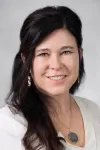Identifying the rise of multi drug resistant E. coli
Largest genomic study of E.coli has tracked the rise of multi-drug resistance (MDR) in Norway
2021-05-11
(Press-News.org) Antibiotic resistance in E. coli has been steadily increasing since the early 2000s despite attempts to control it, a new study suggests. In the biggest genomic survey of E. coli to date, that took more than 16 years in Norway, researchers have successfully tracked the spread of antibiotic resistant genes and have shown that these genes are being transferred between E. coli strains.
Researchers from the Wellcome Sanger Institute and University of Oslo have tracked multidrug resistance in Norway and compared this to a previous study from the UK. They found that resistant strains developed around the same time, but increased more rapidly in the UK population.
The results, published today (10th May) in The Lancet Microbe show that tracking these resistant strains is important in the surveillance and control of drug resistant E. coli, which poses a significant issue in hospitals where it can cause severe infection and mortality. In addition, understanding how these genes are transferred between strains, and what has caused them to acquire drug resistance can help prevent the growth of antibiotic resistance strains.
The bacterium, Escherichia coli is a common cause of bloodstream infections world-wide*, which seem to be increasing over the last decade. E. coli is commonly found in the gut, where it does not cause harm, but if it gets into the bloodstream due to a weakened immune system it can cause severe and life threatening infections. As an added challenge for health care providers, multi-drug resistance (MDR) has become a frequent feature of such infections, and in a worrying number of cases the available treatment options are becoming limited.
In the largest study of its kind, and only the second systematic longitudinal genomic study of bacteremia E. coli, researchers from the Wellcome Sanger Institute and the University of Oslo processed a nation-wide catalogue of samples from more than 3,200 patients to track antibiotic resistance over 16 years. By harnessing the power of large-scale DNA sequencing, they tracked the emergence of drug resistance and compared this to a similar study conducted in the UK**.
The team found that MDR started to increase and show in more strains in the early 2000s due to antibiotic pressure, and now multiple MDR E. coli strains are present in Norway. However, MDR E. coli seems to be more widely present in the UK, despite similar policies in place around antibiotic use. The UK population however is considerably larger than Norway which could explain some of the differences. Further research is needed to allow for closer comparison and to identify the exact factors that cause rapid spread in some locations compared to others.
MDR is relatively rare in bacteria. However, this new study has identified that lineages that previously were not thought to have MDR have acquired drug-resistance genes, showing the increased ability of E. coli to share MDR genes that move horizontally between strains.
Professor Jukka Corander, co-author and Associate Faculty member at the Wellcome Sanger Institute, said: "The high number of samples from the Norwegian population and the level of genomic detail on the strains of bacteria enabled us to make much more far-reaching conclusions than were ever possible before. This study demonstrates the power arising from a systematic national surveillance of resistant organisms, which both collects and makes the data available for in-depth analyses. Without these in place, it would have been impossible to approach the central research questions formulated in the study and find answers to them."
The researchers hope to conduct similar research in the UK to build on previous studies and gain a full data set of 16 years in the UK in order to more closely track MDR resistant E. coli.
Dr Rebecca Gladstone, lead author of the study and Bioinformatician at the University of Oslo, Norway, said: "Being able to estimate the expansion timelines of the MDR clones of E. coli and to identify multiple occasions of novel acquisition of resistance genes is particularly exciting as this is the first time that this has been possible. Understanding and tracking the movement of these drug resistance genes and the strains that carry them are necessary for controlling the spread of drug-resistant bacteria, which is a huge issue in healthcare."
Professor Julian Parkhill, co-author and Professor in the Department of Veterinary Medicine at University of Cambridge, said: "Long-term studies such as this one provide in-depth understanding about the complex epidemiology underlying bloodstream infections. The next step would be further research to detail the factors determining the success of emerging pathogenic clones of these bacteria, to help find a way to control and possibly minimise the spread of multidrug resistance."
INFORMATION:
*Kern WV, Rieg S. (2020) Burden of bacterial bloodstream infection - A brief update on epidemiology and significance of multidrug-resistant pathogens. Clin Microbiol Infect; 26: 151-7.
** Teemu Kallonen, et al. (2017) Systematic longitudinal survey of invasive Escherichia coli in England demonstrates a stable population structure only transiently disturbed by the emergence of ST131. Genome Research. DOI 10.1101/gr.216606.116
Further information on the data collection: In Norway, there is a national de-centralized database where blood isolates of bacteria grown from patient samples are stored permanently, which started in 2001. There are in total >30,000 isolates in that database and this research took a systematic sample from each year, which resulted in the 3,200+ genomes. In addition the database contains results of phenotypic antibiotic resistance tests for all important classes of antibiotics, making it possible to compare genomic predictions from a subset to the whole database.
ELSE PRESS RELEASES FROM THIS DATE:
2021-05-11
As more private data is stored and shared digitally, researchers are exploring new ways to protect data against attacks from bad actors. Current silicon technology exploits microscopic differences between computing components to create secure keys, but artificial intelligence (AI) techniques can be used to predict these keys and gain access to data. Now, Penn State researchers have designed a way to make the encrypted keys harder to crack.
Led by Saptarshi Das, assistant professor of engineering science and mechanics, the researchers used graphene -- a layer of carbon one atom thick -- to develop a novel low-power, scalable, reconfigurable hardware security device with significant resilience ...
2021-05-10
According to the International Whaling Commission, whale-watching tourism generates more than $2.5 billion a year. After the COVID-19 pandemic, this relatively safe outdoor activity is expected to rebound. Two new studies funded by a collaborative initiative between the Smithsonian Tropical Research Institute (STRI) in Panama and Arizona State University (ASU) show how science can contribute to whale watching practices that ensure the conservation and safety of whales and dolphins.
"The Smithsonian's role is to provide scientific advice to policy makers as they pioneer management strategies to promote whale conservation," said STRI marine biologist, Hector Guzmán, whose previous work led the International Maritime Organization to establish ...
2021-05-10
Conducting a discussion in a noisy place can be challenging when other conversations and background noises interfere with our ability to focus attention on our conversation partner. How the brain deals with the abundance of sounds in our environments, and prioritizes among them, has been a topic of debate among cognitive neuroscientists for many decades.
Often referred to as the "Cocktail Party Problem", its central question focuses on whether we can absorb information from a few speakers in parallel, or whether we are limited to understanding speech from only one speaker at a time.
One ...
2021-05-10
Chemotherapy can induce a painful peripheral neuropathy (CIPN), a chronic condition and common adverse effect for cancer patients undergoing treatment. Researchers at University of California San Diego School of Medicine, with colleagues elsewhere, have used a mouse model to demonstrate the pivotal role of cholesterol in CIPN, and proposed a novel therapeutic approach to reverse it.
The findings are published in the May 10, 2021, online issue of the Journal of Experimental Medicine.
The study was a collaboration between the laboratories of senior study author Yury Miller, MD, PhD, professor of medicine, and Tony Yaksh, PhD, professor of anesthesiology and pharmacology, both at UC San Diego School of Medicine. ...
2021-05-10
Evidence of recent volcanic activity on Mars shows that eruptions could have taken place in the past 50,000 years, according to new study by researchers at the University of Arizona's Lunar and Planetary Laboratory and the Planetary Science Institute.
Most volcanism on the Red Planet occurred between 3 and 4 billion years ago, with smaller eruptions in isolated locations continuing perhaps as recently as 3 million years ago. But, until now, there was no evidence to indicate Mars could still be volcanically active.
Using data from satellites orbiting Mars, researchers discovered a previously unknown volcanic ...
2021-05-10
All three species of manatee now present on Earth share a common ancestor from which they split some 6.5 million years ago, when a huge lake in Amazonia, then linked to the Caribbean, was cut off from the sea. The African manatee Trichechus senegalensis is not as genetically close to the West Indian manatee T. manatus as was thought, and adaptation to this complex environment by the Amazonian manatee T. inunguis has left at least one mark in its genetic code.
These are key findings of a study supported by FAPESP and published in Scientific Reports, with hitherto unknown details of the evolutionary history of these aquatic mammals. The authors are an international group of scientists led by researchers at the University of Campinas ...
2021-05-10
The American College of Chest Physicians® (CHEST) recently released new clinical guidelines on the Diagnosis and Evaluation of Hypersensitivity Pneumonitis (HP). The guidelines contain 14 evidence-based recommendations to improve individual diagnostic decision-making and to decrease diagnostic practice variability.
Occurring at any age, HP is an immunologically mediated form of lung disease resulting from inhalational exposure to a large variety of environmental and/or occupational inciting antigens (typically fungal, bacterial, avian). Over the years, the categorization of HP based on clinical features and disease duration coupled with traditional diagnostic criteria has been unhelpful, even when accurate, when separated from a probabilistic diagnostic ...
2021-05-10
Clavelina oblonga, an invasive marine fouling species, not only reduces diversity in communities it invades, it also interferes in their recovery following natural disasters - a process known as "succession."
Succession refers to how an ecosystem recovers after a disturbance or natural disaster - does the system come back more or less the same as it was in terms of species composition, or is it different?
"The classic example of succession is a forest that experiences a wildfire," says Kayla Christianson, former NC State graduate student and first author of a paper describing the research. "As the community recovers from the fire, it proceeds through a predictable pattern of community development - starting with grasses and ending with trees and a mature forest. This ...
2021-05-10
Since it debuted in 2011, the Get SET Early program, which provides pediatricians and parents with a relatively simple process to screen for indicators of autism spectrum disorder (ASD) in children as young as age 1, has steadily grown in use and validation. Early screening and identification of ASD has been linked to more effective treatment.
A new study, published in the April 26, 2021 issue of the END ...
2021-05-10
PHILADELPHIA-- Human brain organoids are remarkable platforms for modeling features of human brain development and diseases. Building on methods to generate organoids to model different brain regions such as the cortex and the midbrain, researchers at the Perelman School of Medicine at the University of Pennsylvania have generated the first organoids of the arcuate nucleus (ARC), an essential structure in the hypothalamus that sends signals of hunger and feeling full. This part of the hypothalamus exhibits a tremendous amount of cell diversity, and is far more complex than previously modeled parts of the brain.
In a paper ...
LAST 30 PRESS RELEASES:
[Press-News.org] Identifying the rise of multi drug resistant E. coli
Largest genomic study of E.coli has tracked the rise of multi-drug resistance (MDR) in Norway




